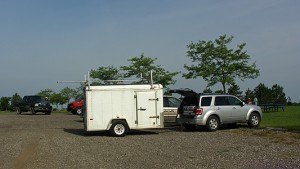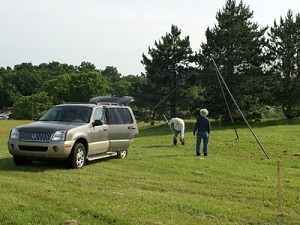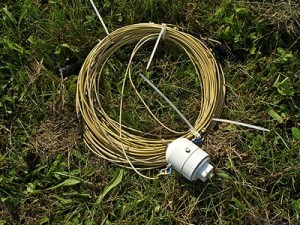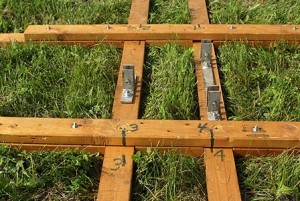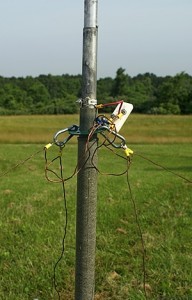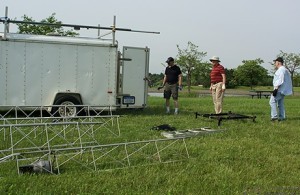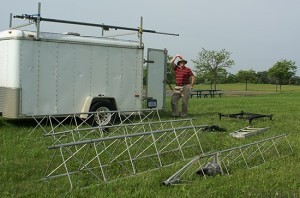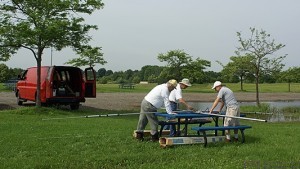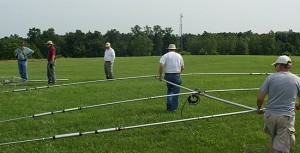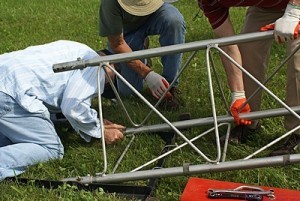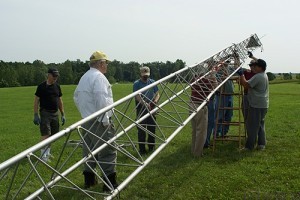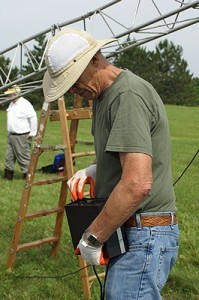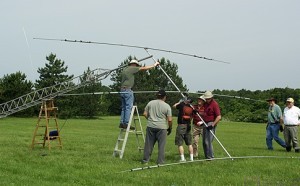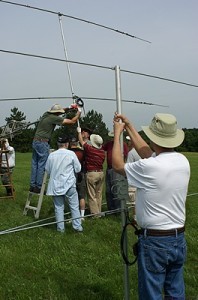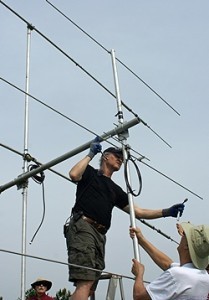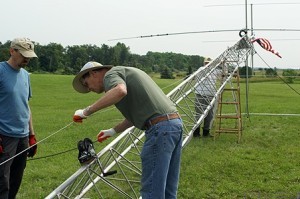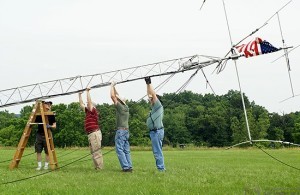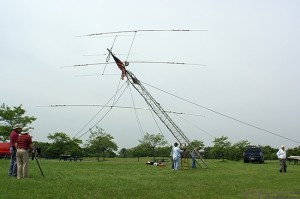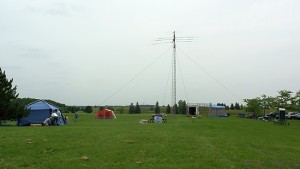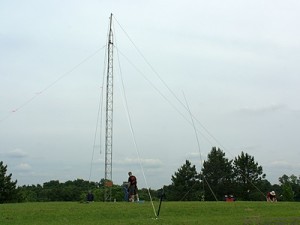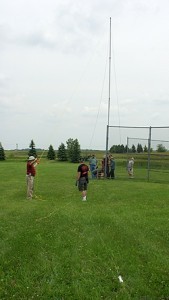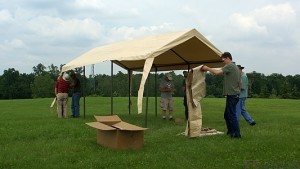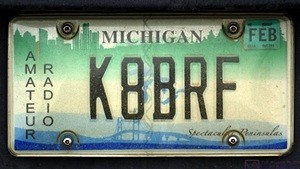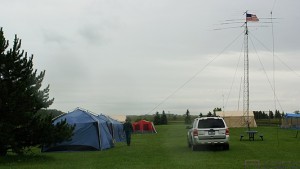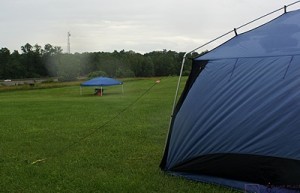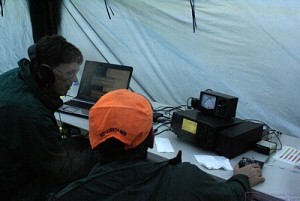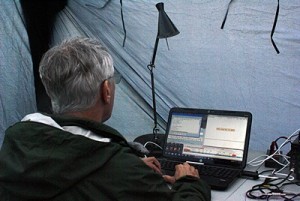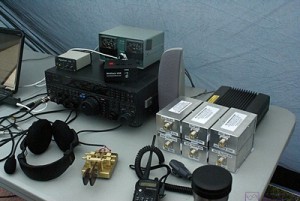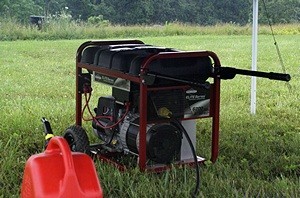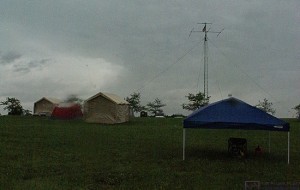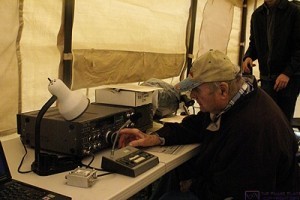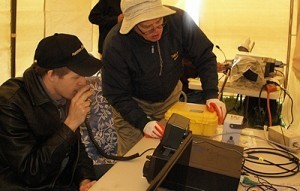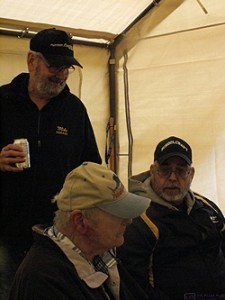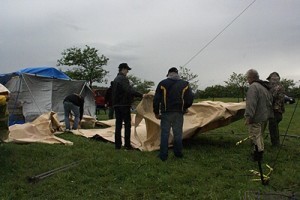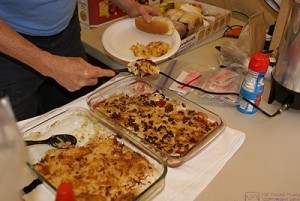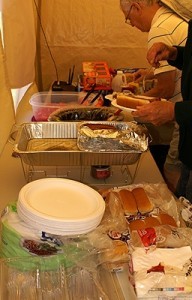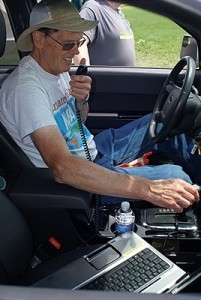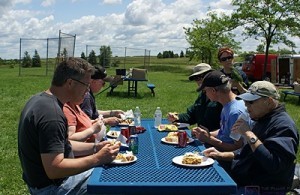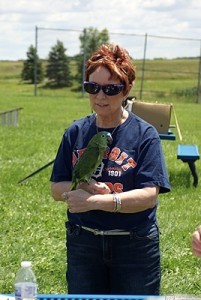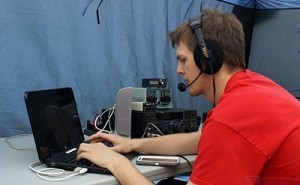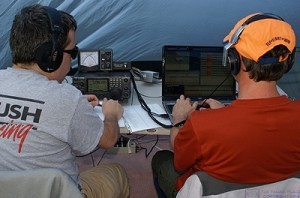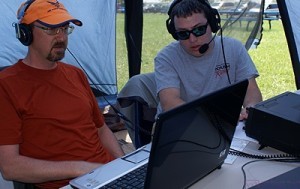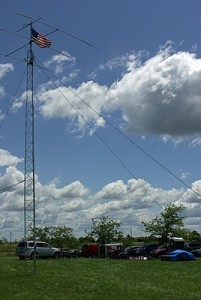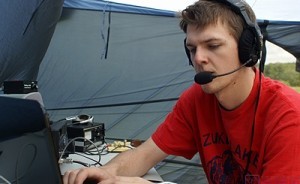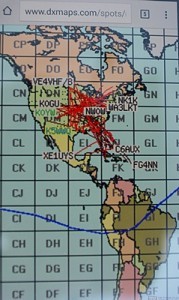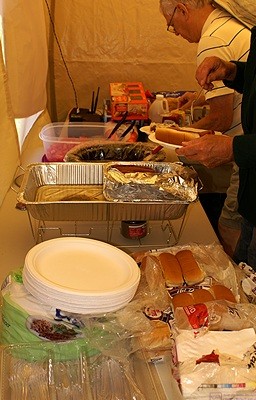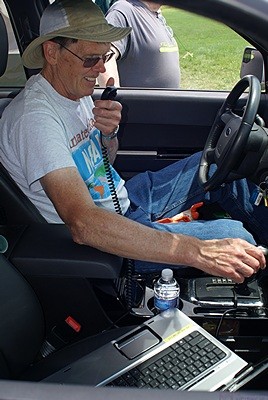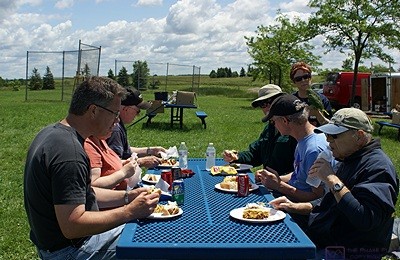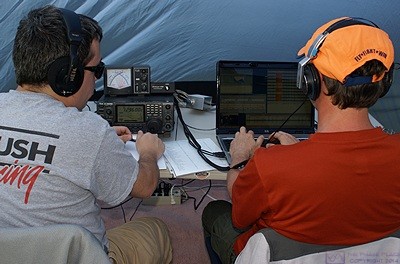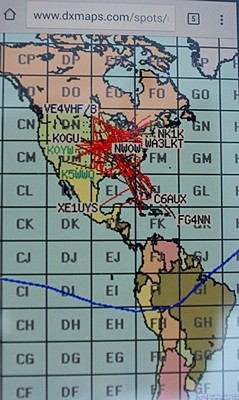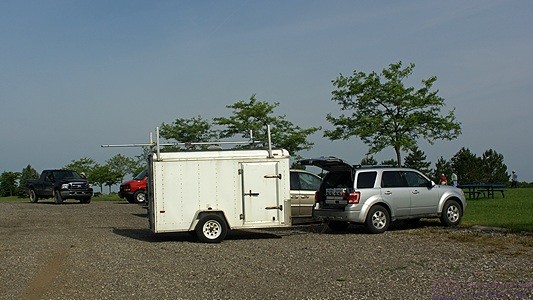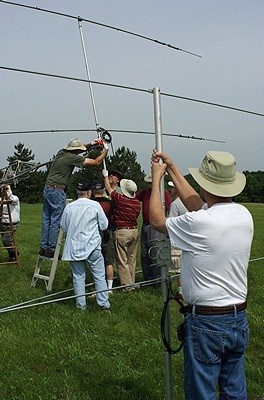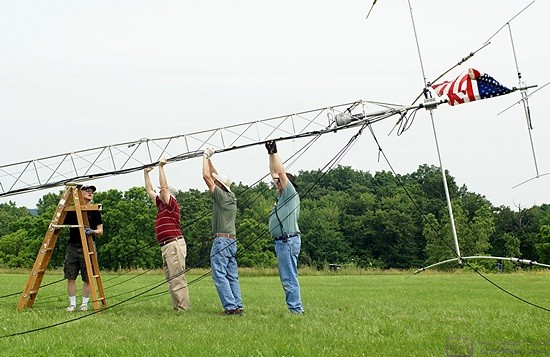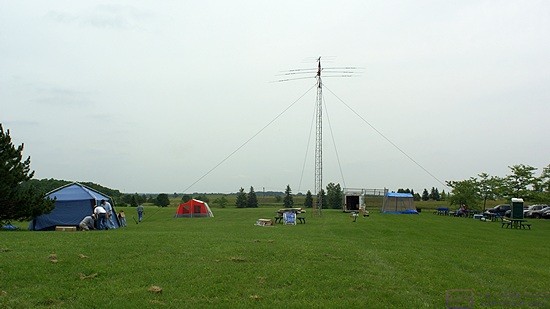At 5 AM I was vaguely aware of the sound of rain. The cats were chasing each other through the house so I got up to make sure nothing was amiss, such as another mouse. They were just having a bout of morning friskiness. I added a little food up to their bowls, which drew their attention, and went back to bed.
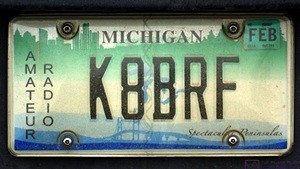
My Amateur Radio vanity license plate. There were a LOT of these in the parking lot at the SLAARC Field Day site.
I finally woke up and got up about 8:15 AM and got dressed in a suitable manner for today’s American Radio Relay League (ARRL) Field Day event. The temperature was in the mid-50s, overcast and raining with blustery winds; not exactly the nice summer day we were all hoping for. Some of the members of the South Lyon Area Amateur Radio Club (SLAARC) were gathering for breakfast at the usual place (Senate Coney Island) at the usual time (8 AM) but we obviously did not join them today.
I went to my office to retrieve my Sony DSLR and decided to turn on our Icom IC-7000 ham radio. I had it tuned to the SLAARC (K8VJ) repeater in South Lyon when Keith, KD8YYJ, announced his presence. He was driving from the west side of Howell to Wixom and seeing what repeaters he could hit. We chatted for 10 to 15 minutes and I invited him to stop by the SLAARC Field Day site at the South Lyon Township James F. Atchison Memorial Park.
I worked all day yesterday as part of the SLAARC Field Day setup crew. There was more setup to do starting at 9 AM this morning but the setup mostly involved radios, computers, Wi-Fi networking, and power. I was not in any humor to rush off into the clammy weather conditions, and Linda was up by this point, so we had breakfast. She found some Silk brand ‘yogurt’ at Meijer’s last week so we had that. It was OK. It is a creamy style yogurt, which is not my preference, but it was tasty enough. Bananas, cinnamon raisin bread, and juice rounded out the meal. Linda even made the coffee. I turned on the natural gas fireplace to ward off the chill in the living room where we lingered and enjoyed our morning brew.
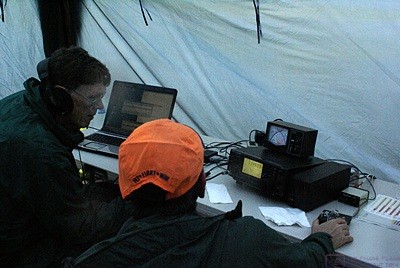
The SLAARC Field Day operating stations use wirelessly networked computers (left) running N1MM Logger+ to record the contacts that are made. HF transceiver to the right.
I finally left for the Field Day site around 11 AM. The operating event started at 2 PM but the first of four meals was lunch today at noon and I wanted to capture photos of the rest of the setup and the lunch event. It was raining lightly when I arrived and continued to rain until I left at 2:15 PM. In between arrival and departure I took some photos and helped out a little bit, but there were plenty of people there taking care of what needed to be done.
Mike (W8XH) brought his Icom IC-2820H dual band mobile radio and several lengths of 50 ohm coax and we transferred those to my car. He then walked me through the various menus and functions his new Yaesu FTM-400DR/DE radio, a dual band (VHF/UHF) 50 Watt rig with digital voice capability and a color touch screen display. A group of SLAARC members recently purchased a Yaesu DR-1X repeater that works with the new Yaesu digital voice and data modes in addition to the traditional FM mode and are testing it as a replacement for the current, and very old, K8VJ repeater.
Mike’s IC-2820H is available for $350 but the FTM-400DR has a $100 rebate through the end of June, bringing the price down to $500. As much as I would like to have a VHF/UHF radio in my car I am looking at one of these radios to install in the cockpit of the bus so we can use it going down the road. The long-term plan is to put the Icom IC-7000 HF/VHF/UHF radio in our towed vehicle and get the Hi-Q 80-6 antenna mounted and operational in addition to the Diamond SG-7900 VHF/UHF antenna that is already on the Honda Element.
For base station use I would like to get an Elecraft K3s or Flex SDR rig. The K3s has become the rig of choice among the members of the SLAARC who are serious about working HF and contesting. Either of those are radios that could be fairly easily moved from the house to the bus when we travel. Antenna options in the bus could include running coax to the Hi-Q on the toad and/or a “flagpole” HF vertical that is mounted using the towbar receiver or a base stand that goes under one of the tires. An antenna switch would allow the use of the VHF/UHF antenna that was already installed for the cockpit radio. All of these “base station” options would obviously be for stationary use only.
[Photo 3 – HC]
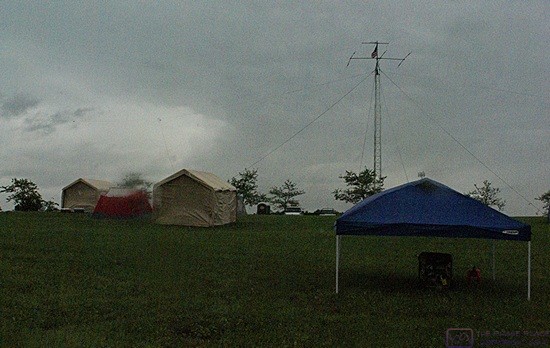
The ARRL FIeld Day event showcases the ability of amateur radio operators to set up equipment in the field on short notice and keep it on the air for 24 hours, no matter what. The weather turned bad for the event. The portable generator is under the tent in the right foreground.
I uncoiled the coax cables that Mike lent me to see how long they were. There was a 5 foot piece that was too short for what I needed, and a piece that was approximately 40 feet, which was longer than I needed. The third piece was at least as long as the 40 footer. I “tagged” his coax with small white cable ties so I could identify them later and return them to him.
I did not want to mess around switching coax cables in the rain so I unboxed Mike’s Icom 2820 and got it set up to use with my existing antenna and transmission lines. I spent a little time with the manual and then powered it up. It was already configured from when Mike used it in his ham shack so I did not need to do any setup to use it. I monitored both the South Lyon 2m and Novi 440 MHz repeaters and was able to “hear” both of them, although the South Lyon signal was much better (stronger, quieter, clearer) than the Novi. A couple of SLAARC members were on the South Lyon repeater taking care of Field Day business. I waited a suitable amount of time after they were done and called for Mike (W8XH) and he came back right away.
We repeated the testing we had done last night. The performance with the 2m South Lyon repeater seemed to be much better but the performance on the 70cm Novi repeater was the same or worse with a fading component to the noise. I think we were on the air 15 to 20 minutes. Based on the test results from last night and this afternoon I think I have two separate issues that are probably interacting; the IC-7000 needs to be grounded and the 25 feet of coax from the cable entry box (CEB) to the radio (Go Box) needs to be shorter and much higher quality. I need to install the ground bar on the wall behind the ham radio desks and then purchase a suitable length of ground wire and run it from the CEB to the copper ground bar. I will also need to get a 15 foot length of 50 ohm LMR-400 coax from Scott (AC8IL) with an N-male connector on one end and a PL-259 connector on the other end.
Linda prepared our dinner at 5 PM. She made corn-on-the-cob and “cowgirl steaks,” a new (to us) vegetable protein product she found at Meijer’s. After dinner we drove back to the SLAARC Field Day site to socialize with club members at dinnertime. The weather at our house was still rainy with light-to-moderate winds and occasional stronger gusts. We arrived at the Field Day site to find a flurry of activity and strong, steady winds out of the north with continued sporadic rain.
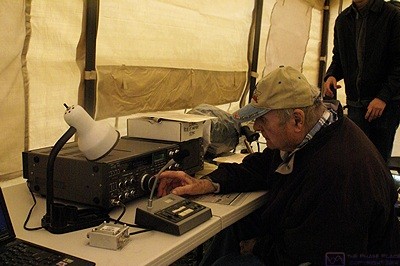
Jim (KC8WMW) stays dry as he works the GOTA (Get On The Air) station in one of the tents.
The small red tent that was originally supposed to be the VHF tent was nowhere to be seen and at least eight people were engaged in trying to control and fold up the large canopy that the club purchased yesterday at Costco to serve as the combined VHF and GOTA tent. We quickly learned that the small tent, which was not being used, had collapsed and the large tent, which was unoccupied but full of radios and computers, had come unstaked and blown over in the wind. Those who were not helping with the equipment canopy were gathered in the food canopy. I pitched in on the equipment canopy rescue and Linda took the camera and joined the folks in the food tent.
After gathering up all of the pieces of the canopy and getting them back in the trailer some of the team added extra ropes and stakes to the windward end of the food canopy and both the 20m and 40m tents. Another part of the team, including me, got Marty’s (KB8JIU) satellite tracking equipment out of the screen room, which had been draped with solid plastic tarps to keep the rain out, and then took the room down, disassembled the legs, folded it up, and stuffed it in the trailer. The red tent was stuffed under a picnic table that was in the screen room so I grabbed that and put it in the trailer. The support pole for one end of our off-center-fed dipoles was bending over to the south more than we liked. Steve, N8AR, tied a rope around the existing rope, which was inline with the antenna and being used to keep it taught. He slid the second rope up the first one as far as he could get it to go and then pulled it out to the northwest (the antenna was oriented east-west with the tension rope running east off of the east end). He pulled it out until the support pole was reasonably vertical and I staked it down.
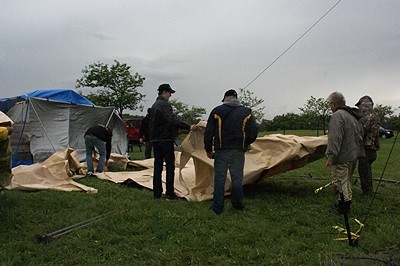
The winds really howled out of the north driving the rain before them. This shelter (from Costco) did not survive along with another tent and a screen room.
So the bad news was that some of our Field Day setup had not survived the weather which had not even reached severe conditions. The good news was that our generator was still producing power, all of our towers and antennas were intact and functional, we had our two key stations on the air, and our food canopy was full of people and hot food. Not the Field Day everyone had hoped for, but a great opportunity for teamwork and camaraderie and a learning experience to be sure, even if it was not the kind of lesson we wanted to learn.
We left around 7:30 PM and went to the New Hudson Lowe’s, which was very close to our Field Day site, where I bought 18 feet of AWG 6 stranded copper wire with a green sheath. As soon as the weather improves I plan to run this from the CEB to the ham shack and use it to connect the ground bar in the shack to the copper backplane (ground plane) in the CEB. I will then connect the ground on our Go Box (Icom IC-7000) to the ground bar and see if it helps with my noise issue.
Back at the house Linda wanted to watch an episode of NCIS Los Angeles, which we can now do thanks to our new OTA TV antenna. We then watched an episode of Christina Cooks, Christina Perillo’s vegan cooking show from a decade ago. These are still relevant and useful episodes and we especially enjoy them having seen and met her and her husband Robert on our two Taste of Health Holistic Holiday at Sea vegan cruises. Linda read and I wrote for a while before lights out and off to sleep.
